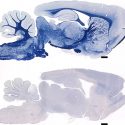Study redefines role of estrogen in cervical cancer
Scientists have prior evidence that the hormone estrogen is a major driver in the growth of cervical cancer, but a new study examining genetic profiles of 128 clinical cases reached a surprising conclusion: Estrogen receptors all but vanish in cervical cancer tumors.
This counterintuitive finding, reported today (June 8) in the online Proceedings of the National Academy of Sciences, further bolsters the understanding of cervical cancer’s progression and offers valuable new targets to fight the disease.
Lead author Johan den Boon, associate scientist with the Morgridge Institute for Research at the University of Wisconsin–Madison, says the research team used gene expression profiling on 128 specimens from the Study to Understand Cervical Cancer Early Endpoints and Determinants, or SUCCEED. More than 4,000 women are participating in the SUCCEED study, a major effort to understand the second-leading cause of cancer in women globally. It is led by the National Cancer Institute (NCI) and the University of Oklahoma Health Sciences Center.
Virtually all cervical cancers derive from human papillomavirus (HPV) infection. The specimens in this study came from four distinct groups — healthy patients, patients with either early or advanced complications due to HPV infection, and those with cervical cancer. Den Boon says these four groups allowed researchers to study the full progression from viral infection to cancer — a unique opportunity among human cancers.
“Our top goal is to find genetic signatures that will predict what early stages of HPV infection are most likely to become cancerous, and what stages we need to worry less about,” says den Boon, of the Morgridge Virology team led by University of Wisconsin–Madison and Morgridge scientist Paul Ahlquist.
A hallmark of HPV-associated disease is a dramatic increase in levels of a protein called p16, which normally is involved in regulating cell division. In profiling gene expression in the 128 specimens, the study posed the question: What other genes might be behaving like P16? This is where authors encountered the surprise estrogen receptor expression. “It does the complete opposite of p16,” den Boon says. “Estrogen receptor is in the healthy cells. But as the cells become cancerous, the levels of estrogen receptor alpha crash to the point of being undetectable.”
Den Boon says the team was “stunned” by the finding and at first assumed there was a flaw in the study. “P16 and estrogen were as polar opposite as you can get. When looking at similarities between the 54,000 measurements we have on the human genome, p16 would be number one and estrogen would be 54,000.”
Other measurements for hundreds of other genes that respond to estrogen made it clear that levels of the estrogen receptor and of the genes it controls are a powerful marker for cervical cancer progression, he says.
The group conducted microscopic analysis of the samples for further insights. Here, they observed that while estrogen receptor was absent in cancer cells, it was prevalent and in many cases increased in the so-called tumor microenvironment — the area around the tumor that helps it grow.
The finding highlights that something critical is happening between the microenvironment and the tumor itself, allowing the tumor to thrive in spite of its inability to “see” estrogen. “If we want to understand the role of estrogen, we now have to look at how the tumor and the microenvironment communicate with one another,” den Boon says.
The next phase of this puzzle is under way. Postdoctoral fellow Omid Forouzan, who is in a joint position at Morgridge and with UW–Madison biomedical engineer David Beebe, will lead the tumor signaling project. The project will rely on microfluidics techniques pioneered by Beebe.
“What David’s group can do is grow populations of cells in a very miniaturized state in ways that they can reach out and talk to each other through tiny channels, but yet they stay distinct,” den Boon says.
One could think of it as molecular espionage. The project will attempt to intercept the biochemical signals that are going back and forth between the microenvironment and the tumor. This is where small molecule therapeutics could be developed to interfere with the signals and suppress tumor growth.
Cervical cancer, which used to be the leading cause of cancer deaths for women in the United States, is a medical success story in developed nations. Thanks to widespread early screening via Pap tests and the availability of an HPV vaccine, rates in the U.S. are down to about 12,000 cases and 4,000 deaths annually.
But it remains a major threat globally, with more than 500,000 new cases per year — about half of which will be fatal. It’s the third leading cause of cancer deaths for women worldwide. Early detection and treatment of lesions caused by HPV can all but eliminate the onset of cervical cancer, but many countries do not have access to early screening tests. Further, the HPV vaccines are among the most expensive vaccines available and their implementation is far from complete.
This study offers another avenue to target and alter the disease progression. Since estrogen also plays an important role in other cancers, including breast cancer and prostate cancer, den Boon says this work has the potential to benefit other cancer-fighting efforts.
Funding for the project comes from the National Institutes of Health and the Morgridge Institute. Ahlquist, a fellow of the Howard Hughes Medical Institute (HHMI), worked closely on the project with Nico Wentzensen of the NCI and Joan Walker at the University of Oklahoma.
Other Madison contributors include Mark Horswill from Morgridge; Paul Lambert from the UW–Madison McArdle Laboratory for Cancer Research; and Rachel Pearson and Meghan Scott from the UW–Madison Institute for Molecular Virology.



